List of Top 10 Freedom Fighters of India: Contributions & Role In Independence
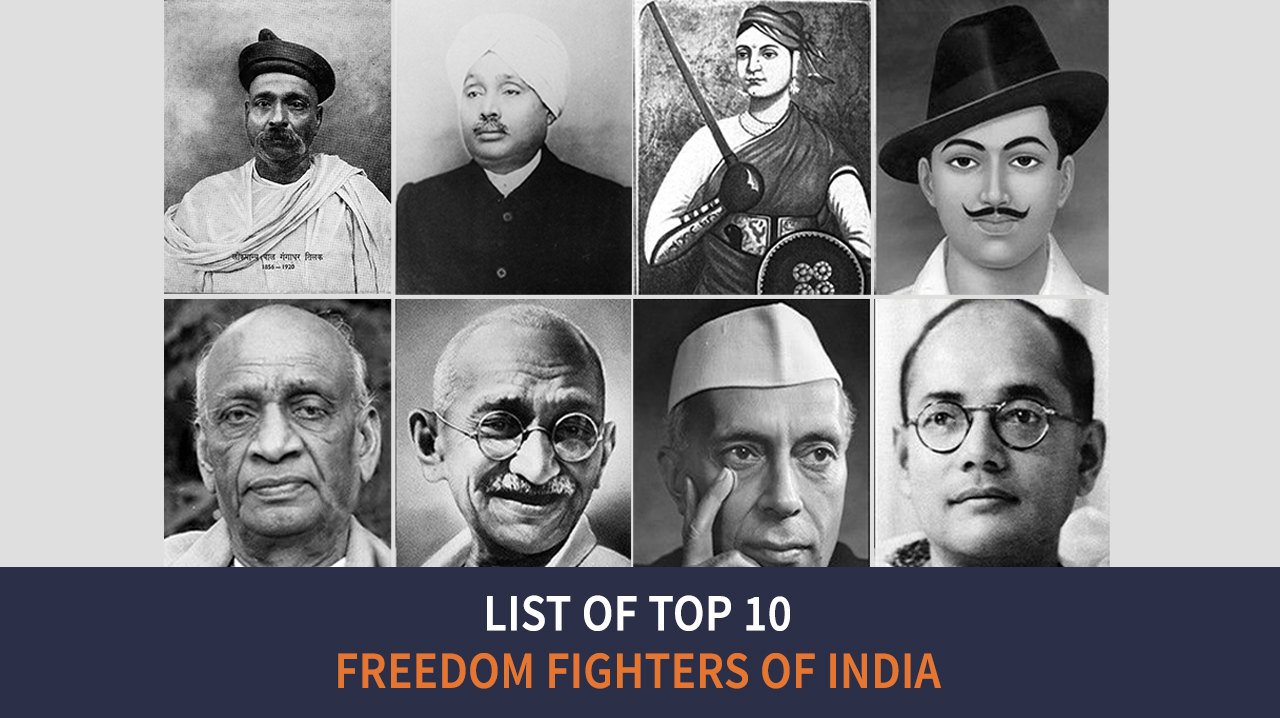
On the historic date of 15 August 1947, India became free from British domination. Throughout this time, India freedom fighters, inculcated in numerous struggles and movements.
The independence was achieved only after various revolts by revolutionary Indian freedom fighters, including Jawaharlal Nehru, Mahatma Gandhi, Rani Lakshmibai of Jhansi, Chandrasekhar, Azad, and many more. They took part in organising the struggle that resulted in India’s independence. These Indian freedom fighters sacrificed their lives to ensure India’s independence.
- Independence & India’s Freedom Struggle
The Indians felt like one as they tried to overthrow the following rules. It led to the independence and Indian freedom struggle. Moreover, the Indian independence movement consisted of a series of historical events that ultimately aimed at ending British rule. The struggle lasted from 1857 to 1947.
With the rise of the sepoy mutiny, to establish the Indian national congress, followed by Lucknow, pact and other freedom movements, India’s struggled all the way to achieve independence.
- Role of Freedom Fighters In India’s Independence
During the Indian Independence, the Indian freedom fighters or the true heroes. They sacrificed their lives for India, their motherland. However, the independence of India was achieved due to the courage and sacrifice of these freedom fighters of India.
With the Indian struggle for independence, the history is filled with chaotic and violent battles, uprisings and movement. Due to this reason, hundreds and thousands of patriotic and brave Indian freedom fighters sought against British rule for their independence.
Top 10 Freedom Fighters Of India Images With Names
Here is the list of Top 10 freedom fighters of India.
1. Mahatma Gandhi: Known as the “Father of the Nation”
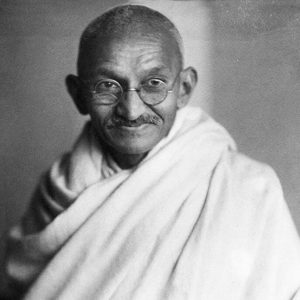
Born: October 2, 1869 (Porbandar, Gujarat, India)
Parents: Karamchand Gandhi (Father) and Putlibai Gandhi (Mother)
Spouse: Kasturba Gandhi
Designation: Political and Spiritual Leader, Advocate of Nonviolent Resistance
Assassinated: January 30, 1948 ( New Delhi, India)
Role: Leader of the Indian National Congress and advocate of nonviolent resistance.
Contributions: Led various nonviolent movements, such as the Salt March and the Quit India Movement, to protest against British colonial rule. His philosophy of nonviolence inspired millions and played a crucial role in India’s struggle for independence.
2. Sardar Vallabhbhai Patel: Known as the “Iron Man of India”
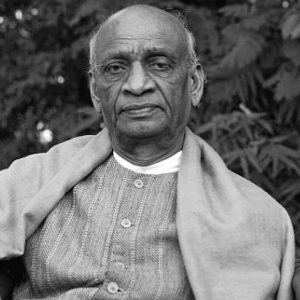
Born: October 31, 1875 (Nadiad, Gujarat, India)
Parents: Jhaverbhai Patel (Father) and Ladbai Patel (Mother)
Spouse: Jhaverba Patel
Designation: Political and Social Leader, First Deputy Prime Minister and Minister of Home Affairs of India
Assassinated: December 15, 1950 (Bombay (now Mumbai), Maharashtra, India)
Role: Political and social leader, known as the “Iron Man of India.”
Contributions: Played a pivotal role in the integration of princely states, uniting them into the newly independent India. He served as the first Deputy Prime Minister and first Minister of Home Affairs of India.
3. Jawaharlal Nehru: Known as “Pandit Nehru” & Also referred to as “Architect of Modern India”
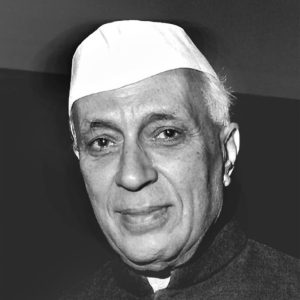
Born: November 14, 1889 (Allahabad, Uttar Pradesh, India)
Parents: Motilal Nehru (Father) and Swaruprani Thussu (Mother)
Spouse: Kamala Nehru
Designation: Political Leader, First Prime Minister of independent India.
Assassinated: May 27, 1964 (New Delhi, India)
Role: First Prime Minister of independent India and a prominent leader of the Indian National Congress.
Contributions: Played a key role in the Indian independence movement and worked towards establishing a democratic and socialist society in India. He implemented various socio-economic reforms and advocated for secularism and nonalignment on the international stage.
4. Bhagat Singh: Often called “Shaheed Bhagat Singh” (Martyr Bhagat Singh)
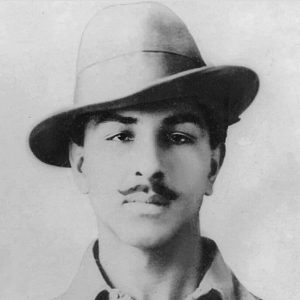
Born: September 28, 1907 (Banga, Lyallpur district, Punjab, British India)
Parents: Kishan Singh (Father) and Vidyavati (Mother)
Spouse: No record of him being married
Designation: Revolutionary and Socialist Leader
Assassinated: March 23, 1931 (Lahore, Punjab, British India)
Role: Revolutionary and socialist leader.
Contributions: Played a significant role in the fight against British rule through acts of resistance. He was involved in the Lahore Conspiracy Case and became a symbol of the revolutionary movement. He sacrificed his life for the cause of independence.
5. Netaji Subhas Chandra Bose: Known as “Netaji” (Respected Leader)
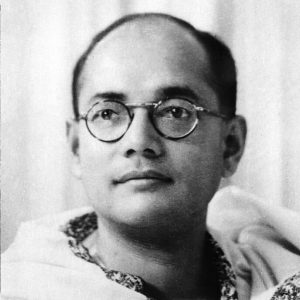
Born: January 23, 1897 (Cuttack, Odisha, India)
Parents: Janakinath Bose (Father) and Prabhavati Devi (Mother)
Spouse: Emilie Schenkl
Designation: Political Leader, Leader of Forward Bloc, Founder of the Indian National Army (INA)
Assassinated: August 18, 1945 (disputed) (Unknown and subject to controversy)
Role: Leader of the Forward Bloc and the Indian National Army (INA).
Contributions: Fought against British colonialism and played a crucial role in organizing the INA, which aimed to liberate India from British rule with the help of Japanese forces. He advocated for armed struggle and created an alternate front in the fight for independence.
6. Chandrashekhar Azad: Often referred to as “Azad” (The Free)
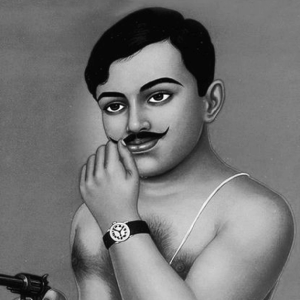
Born: July 23, 1906 (Bhavra, Alirajpur district, Central India Agency (now in Madhya Pradesh, India)
Parents: Sitaram Tiwari (Father) and Jagrani Devi (Mother)
Spouse: No record of him being married
Designation: Revolutionary Leader and Freedom Fighter
Assassinated: February 27, 1931 (Alfred Park (now Chandrashekhar Azad Park), Allahabad, Uttar Pradesh, India)
Role: Revolutionary and prominent member of the Hindustan Socialist Republican Association.
Contributions: Played an active role in the Kakori Train Robbery and other revolutionary activities against British rule. He was a fierce advocate of complete independence and refused to surrender to the British, choosing death over capture.
7. Lala Lajpat Rai: Often called “Punjab Kesari” (Lion of Punjab)
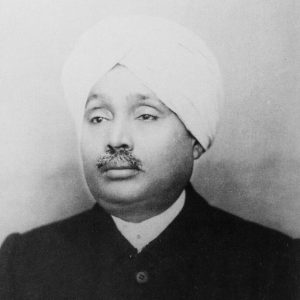
Born: January 28, 1865 (Dhudike, Punjab, British India)
Parents: Munshi Radha Krishna Azad (Father) and Gulab Devi (Mother)
Spouse: Radha Devi
Designation: Nationalist Leader and Advocate of Indian Independence
Assassinated: November 17, 1928 (Lahore, Punjab, British India)
Role: Prominent nationalist leader and advocate of Indian independence.
Contributions: Actively participated in various nationalist movements, including the Non-Cooperation Movement. He was instrumental in establishing national schools and colleges to promote education and played a key role in shaping public opinion against British rule.
8. Bipin Chandra Pal: Sometimes referred to as “Deshbandhu” (Friend of the Nation)
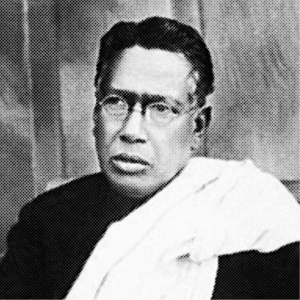
Born: November 7, 1858 (Habiganj, Sylhet District, Bengal Presidency (now in Bangladesh)
Parents: Surya Narayan Pal (Father) and Ramakrishna Devi (Mother)
Spouse: Nivedita Devi (also known as Kadambari Devi)
Designation: Nationalist Leader, Orator, Writer, and One of the Moderates in the Indian National Congress
Assassinated: May 20, 1932 ( Calcutta (now Kolkata), Bengal Presidency, British India (now in West Bengal, India)
9. Bal Gangadhar Tilak: Known as “Lokmanya Tilak” (Beloved Leader Tilak)
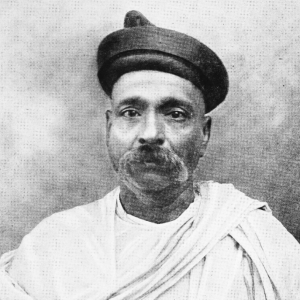
Born: July 23, 1856 (Ratnagiri, Maharashtra, British India)
Parents: Gangadhar Tilak (Father) and Parvatibai Tilak (Mother)
Spouse: Tapibai
Designation: Nationalist Leader, Social Reformer, Political Activist
Assassinated: August 1, 1920 (Bombay (now Mumbai), Maharashtra, British India)
Role: Nationalist leader, social reformer, and scholar.
Contributions: Played a significant role in the Indian independence movement and popularized the slogan “Swaraj is my birthright.” He advocated for self-rule, cultural revival, and worked towards the empowerment of the masses through education and social reforms.
10. Rani Lakshmibai: Often referred to as “Rani of Jhansi” or “Jhansi Ki Rani”
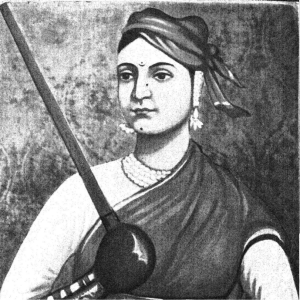
Born: November 19, 1828 (Varanasi, Uttar Pradesh, British India)
Parents: Moropant Tambe (Father) and Bhagirathi Sapre (Mother)
Spouse: Gangadhar Rao Newalkar
Designation: Queen of the princely state of Jhansi, Symbol of Resistance during the Indian Rebellion of 1857
Assassinated: June 18, 1858 (Gwalior, Madhya Pradesh, British India)
Role: Queen of the princely state of Jhansi and symbol of resistance.
Contributions: Played a prominent role in the Indian Rebellion of 1857 against British rule. She led her army in several battles and fought bravely until her last breath. She became a symbol of courage and resistance for freedom fighters during the independence movement.
List of Freedom Fighters of India
Here is the List of Freedom Fighters of India.
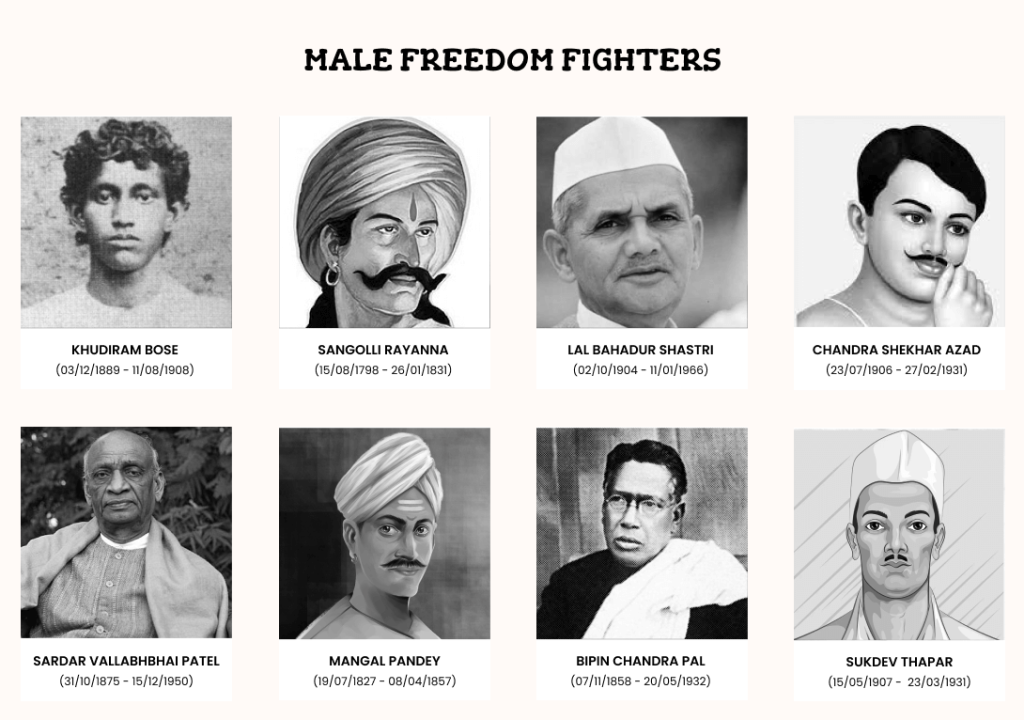
- Mangal Pandey
- Sukhdev Thapar
- Chandra Shekhar Azad
- Sardar Vallabhbhai Patel
- Lal Bahadur Shastri
- Sangolli Rayanna
- Bipin Chandra Pal
- Khudiram Bose
Some of the Greatest Female Freedom Fighters of India are Listed Below.
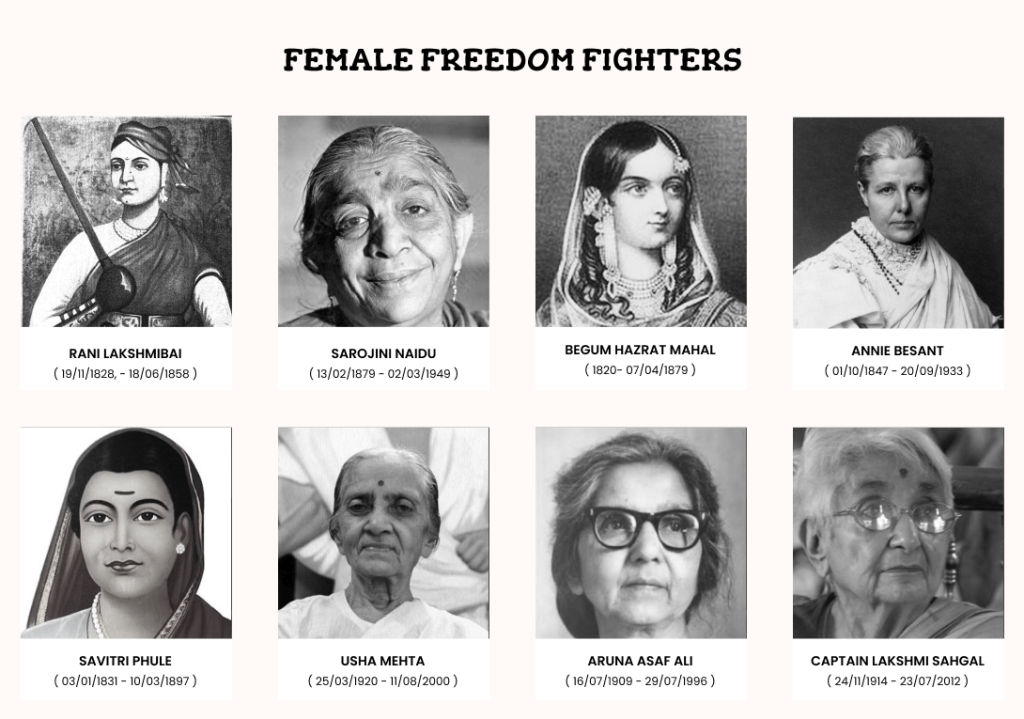
- Rani Lakshmibai
- Sarojini Naidu
- Begum Hazrat Mahal
- Annie Besant
- Savitri Phule
- Usha Mehta
- Aruna Asaf Ali
- Captain Lakshmi Sahgal
Apart From These Freedom Fighters, Other Famous Freedom Fighters of India Includes:
- Dr Zakir Hussain
- Ashraf Ali
- Maulana Mazharul Haque
- Abdul Ghaffar Khan
The Unsung Heroes or The Lesser-known Indian Freedom Fighters Ware:
- Tiruppur Kumaran
- Mathangini Hazra
- Kanaiyalal Maneklal Munshi
- Parvathi Giri
Indian Independence Movements: List Of Major Freedom Movements Happned In India
- 1857 – revolt of 1857 or the sepoy mutiny
- 1905 to 1911 – Swadeshi movement that caused partition of Bengal by Lord Curzon.
- 1914 to 1917 – Ghadar movement that marked the Komagata Maru incident.
- 1916 to 1918 – home rule movement where Bal Bal Gangadhar Tilak launched the movement with Annie Besant
- 1917 – the Champaran satyagraha which was led by Mahatma Gandhi
- 1919 – Rowlatt satyagraha
- 1920 – Khilafat and non-cooperation movement. It was the first movement led by Mahatma Gandhi.
- 1930 – civil disobedience movement launched to break the salt law
- 1940– individual satyagraha was launched against the August offer
- 1942 – quit India movement. Mahatma Gandhi launched his third major movement against British rule.
Now at this point, you came to know about freedom fighters in India. The freedom fighters of India motivated and inspired others to fight injustice. They are actually the pillars behind the Indian freedom movement. People came to know about their rights and their power due to the struggle and sacrifice of the freedom fighters. It is all because of them that we prospered into a free country from any kind of injustice or colonisers.
FAQs
Mohandas Karamchand Gandhi is known as the father of the nation in India.
Baji Rout was the youngest Indian freedom fighter.
During the Indian freedom struggle, the woman caught with true spirit and undaunted courage. They faced exploitation, hardship and various tortures.
India won its freedom from the British colonial rule in 1947, after many decades of struggle.
Ballia was the first city that got freedom in India. It got independence on 19 August 1942.
Mangal Pandey was the first freedom fighter of India.
Sardar Vallabh Bhai Patel is known as the iron man of India for his contribution in the unification of India.
Lala Lajpat Rai was known as the Punjab Kesari of India.
Mahatma Gandhi, Shankar Lal Banker, Indulal Yagnik, Ravishankar, Vyas, Mohanlal, Pandya, and Narhari Parikh participated in the satyagraha movement along with other freedom fighters.
The Quit India movement was a movement launched at the Bombay session of the all India Congress committee on 8 August 1942 by Mahatma Gandhi. It demanded an end to the British rule in India
Round table conference was a series of peace meetings that took place in three sessions. It was organised by the British government to discuss the constitutional reforms in India.


